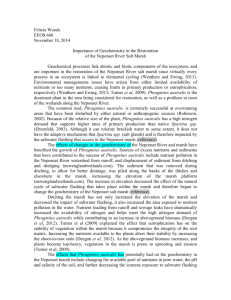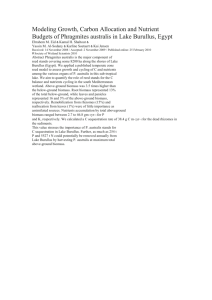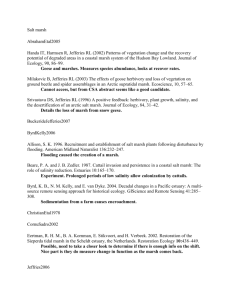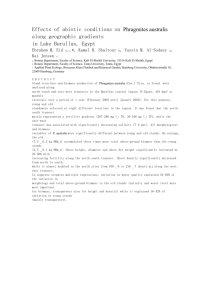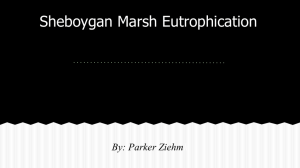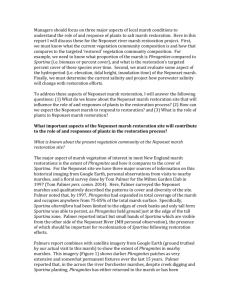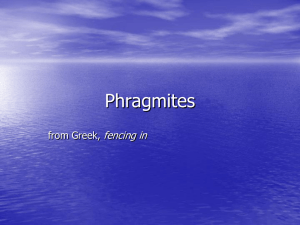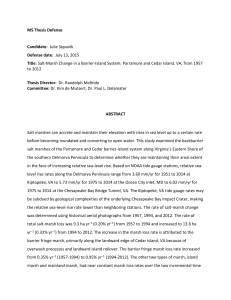EEOS_660_Woods_partII_Geochem - BIOEEOS660-f12
advertisement
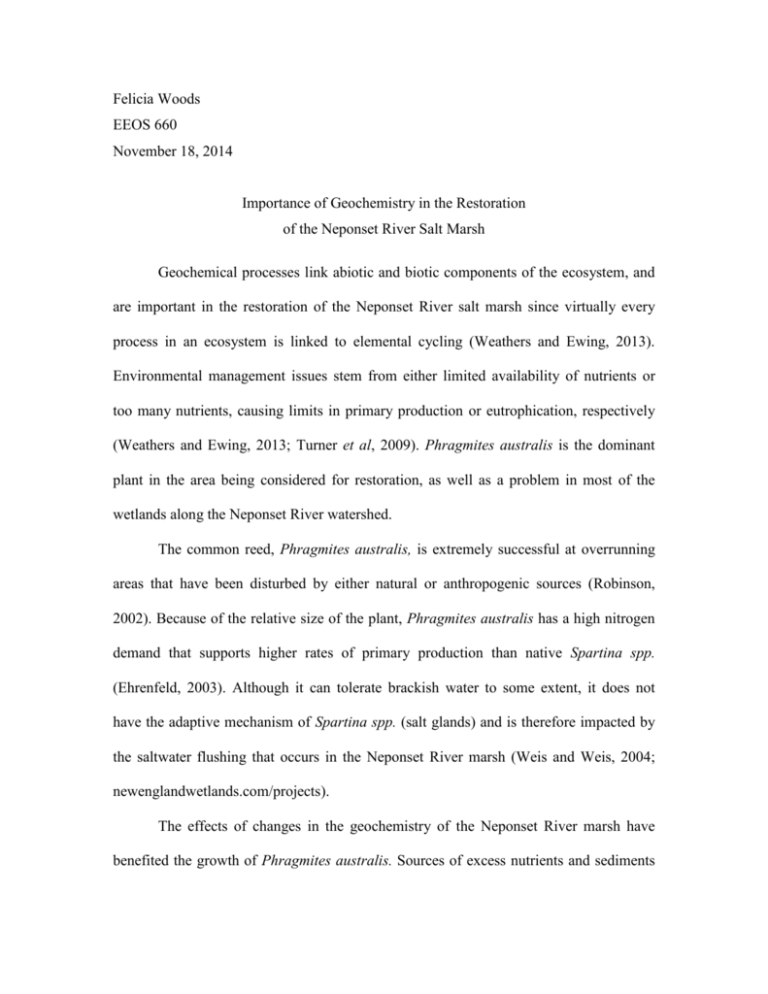
Felicia Woods EEOS 660 November 18, 2014 Importance of Geochemistry in the Restoration of the Neponset River Salt Marsh Geochemical processes link abiotic and biotic components of the ecosystem, and are important in the restoration of the Neponset River salt marsh since virtually every process in an ecosystem is linked to elemental cycling (Weathers and Ewing, 2013). Environmental management issues stem from either limited availability of nutrients or too many nutrients, causing limits in primary production or eutrophication, respectively (Weathers and Ewing, 2013; Turner et al, 2009). Phragmites australis is the dominant plant in the area being considered for restoration, as well as a problem in most of the wetlands along the Neponset River watershed. The common reed, Phragmites australis, is extremely successful at overrunning areas that have been disturbed by either natural or anthropogenic sources (Robinson, 2002). Because of the relative size of the plant, Phragmites australis has a high nitrogen demand that supports higher rates of primary production than native Spartina spp. (Ehrenfeld, 2003). Although it can tolerate brackish water to some extent, it does not have the adaptive mechanism of Spartina spp. (salt glands) and is therefore impacted by the saltwater flushing that occurs in the Neponset River marsh (Weis and Weis, 2004; newenglandwetlands.com/projects). The effects of changes in the geochemistry of the Neponset River marsh have benefited the growth of Phragmites australis. Sources of excess nutrients and sediments that have contributed to the success of Phragmites australis include nutrient pollution in the Neponset River watershed from runoff, and displacement of sediment from ditching and dredging (newenglandwetlands.com/projects). The sediment that was removed during ditching, to allow for better drainage, was piled along the banks of the ditches and elsewhere in the marsh, increasing the elevation of the marsh platform (newenglandwetlands.com/projects). The increase in elevation decreased the effect of the natural cycle of saltwater flushing that takes place within the marsh and therefore began to change the geochemistry of the Neponset salt marsh (newenglandwetlands.com /projects). Ditching the marsh has not only increased the elevation of the marsh and decreased the impact of saltwater flushing, it also increased the area exposed to nutrient pollution in the water. Nutrient loading from runoff and sewage leaks have dramatically increased the availability of nitrogen and helps meet the high nitrogen demand of Phragmites australis while contributing to an increase in aboveground biomass (Deegan et al, 2012). Turner et al (2009) explained the effect that eutrophication has on the stability of vegetation within the marsh because it compromises the integrity of the root matrix. Increasing the nutrients available to the plants alters their stability by increasing the shoot-to-root ratio (Deegan et al, 2012). As the aboveground biomass increases, and plants become top-heavy, vegetation in the marsh is prone to uprooting and erosion (Turner et al, 2009). The effects that Phragmites australis has potentially had on the geochemistry in the Neponset marsh include changing the pool of nutrients in pore water, the pH and salinity of the soil, and further decreasing the systems exposure to saltwater flushing Woods 2 (Ehrenfeld, 2003; newenglandwetlands.com/projects). The density of the Phragmites stems traps a considerable amount of sediment, further increasing the elevation and decreasing saltwater flushing. The reductions in water flow and flood retention caused by the increased sediment retention further impact nutrient cycling (Ehrenfeld, 2003). The area in consideration has become a monoculture of Phragmites australis and changes in nutrient cycling can also result from changes in the biodiversity in the marsh (Ehrenfeld, 2003; Neponset River Watershed Wetlands Restoration Plan, 2000). A decrease in the effectiveness of nutrient cycling can result from a decrease in biodiversity (Weathers and Ewing, 2013). For example, carbon fluxes associated with the deposition of litter typically vary with different species of plant. While the stems of Phragmites australis decompose slower than those of Spartina spp., the leaves decompose faster (Ehrenfeld, 2003). The changes in nutrient cycling resulting from differences in the dominant vegetative species in the marsh can contribute to variations in the microbial community (Ehrenfeld, 2003). Changes in the microbial community attributed to fluctuations in nutrient quality and quantity further alter the geochemistry of the marsh (Ehrenfeld, 2003). Both physical and physiological differences in Phragmites australis and Spartina spp. contribute to changes in soil salinity (Ehrenfeld, 2003). Physical differences contributing to changes in soil salinity when Phragmites australis invades areas native to Spartina spp. are due to changes in ground shading. The taller, thicker biomass of Phragmites australis reduces evaporation in the soil because of the increase in ground cover and therefore decreases salinity (Ehrenfeld, 2003). The main physiological difference between the two species is the presence of salt excretion glands in Spartina Woods 3 spp.; Phragmites australis isn’t able translocate and excrete salt through its leaves (Ehrenfeld, 2003). The high nitrogen uptake of Phragmites australis increases denitrification rates in brackish marshes, such as the Neponset salt marsh, and affects the nitrogen pools in pore water (Ehrenfeld, 2003). By decreasing the pool of ammonium (NH4+) in pore water, it also contributes to changes in the pH of the surface soil of the marsh (Ehrenfeld, 2003). However, Phragmites is used in some wetlands to treat wastewater contaminated with metals because of it ability to take up metals from soil (Weis and Weis, 2004). Although this may not be the case in the Neponset River marsh (no data was found on it), it may have an impact on the ecosystem if Phragmites is completely removed. While the presence of Phragmites australis may cause changes in the geochemistry of the Neponset River marsh, the removal of it could also dramatically impact the ecosystem. Since most elements follow the same path as nutrient cycling, marshes have been proposed as potential sites for phytoremediation (Weathers and Ewing, 2013; Weis and Weis, 2004). Phragmites australis sequesters more metals than Spartina spp. because it doesn’t release the toxic substances back into the marsh environment through leaf excretion (Weis and Weis, 2004). Although replacing Phragmites with Spartina would remove the metal contaminants from the soil, it isn’t able to contain the contaminants like Phragmites (Weis and Weis, 2004). However, more research needs to be done to explore the effect of the translocation of the pollutants, and what complications could arise from the decomposition of the below ground biomass of Phragmites (Weis and Weis, 2004). Woods 4 Removal of Phragmites australis may reduce the rate of primary production in the marsh (Ehrenfeld, 2003), but it will definitely decrease phytoremediation of metals and other potentially toxic elements (Weis and Weis, 2004). Another impact that the removal of Phragmites australis would have on the geochemistry of the Neponset River marsh would be the increase of biodiversity because of the decreased competition for space. However, little has been done to manage the regrowth of Phragmites australis in areas that it has been removed in restoration attempts and, if left unchecked, it can quickly take over again. Some restoration work was done on a section of the marsh in 2005 to manage the growth of Phragmites australis along the Neponset River (newenglandwetlands.com /projects). The work done by Great Meadows, LLC under the guidance of the Massachusetts Department of Conservation and Recreation involved removing dredge spoil to decrease the elevation of the marsh in the area (newenglandwetlands.com /projects). The goal of the project was to once again expose the area to salt water flushing in an attempt to return the area to a healthy marsh ecosystem. However, the work done on the marsh has not had follow-up testing or observations taken to check on the progress of the project. Very little research has been done on geochemistry in the Neponset River marsh, and what research has been done doesn’t include soil chemistry. Even though water chemistry is important to ecosystem functions, the soil chemistry in the Neponset marsh can be an extremely important factor contributing to the success of any restoration attempts that will be made. Understanding how, or if, soil composition differs in areas dominated by Phragmites australis, compared to that of the soil in the more natural Woods 5 Spartina spp. dominated areas, could be the basis of management via geochemistry. However, even though the removal of the Phragmites will reduce the accumulation of sediment and potentially promote Spartina regrowth, the removal would also decrease the rate of primary production in the marsh, decreasing the rate of carbon sequestration. Knowing how the geochemistry affects the growth of Phragmites australis and how it in turn affects the geochemistry of the Neponset River marsh is the first step to planning a successful restoration project. Woods 6 References: Deegan, L., Johnson, D., Warren, R., Peterson, B., Fleeger, J., Fagherazzi, S., & Wollheim, W. (2012). Coastal eutrophication as a driver of salt marsh loss. Nature, 490, 388-392. Ehrenfeld, J. (2003). Effects of Exotic Plant Invasion on Soil Nutrient Cycling Processes. Ecosystems, (6), 503-523. http://www.falw.vu.nl/en/images/ehrenfeld_tcm24-80025.pdf Neponset River Watershed Wetlands Restoration Plan http://www.mass.gov/envir/massbays/pdf/moris/neponset_wetlands_restoration_p lan.pdf Robinson, M. (2002). Common Reed: An Invasive Wetland Plant Phragmites australis. http://www.mass.gov/eea/docs/dcr/watersupply/lakepond/factsheet/phragmites.pd f Turner, R., Howes, B., Teal, J., Milan, C., Swenson, E., & Goehringer-Toner, D. (2009). Salt marshes and eutrophication: An unstable outcome. Limnology and Oceanography, 54(5), 1634-1642. Weathers, K., & Ewing, H. (2013). Element Cycling. In Fundamentals of Ecosystem Science (pp. 97-108). Amsterdam: Academic Press/Elsevier Weis, J., & Weis, P. (2004). Metal uptake, transport and release by wetland plants: Implications for phytoremediation and restoration. Environment International, 30, 685-700. http://newenglandwetlands.com/projects/ Woods 7
